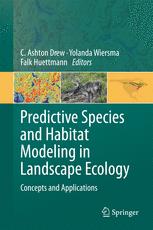

Most ebook files are in PDF format, so you can easily read them using various software such as Foxit Reader or directly on the Google Chrome browser.
Some ebook files are released by publishers in other formats such as .awz, .mobi, .epub, .fb2, etc. You may need to install specific software to read these formats on mobile/PC, such as Calibre.
Please read the tutorial at this link: https://ebookbell.com/faq
We offer FREE conversion to the popular formats you request; however, this may take some time. Therefore, right after payment, please email us, and we will try to provide the service as quickly as possible.
For some exceptional file formats or broken links (if any), please refrain from opening any disputes. Instead, email us first, and we will try to assist within a maximum of 6 hours.
EbookBell Team

5.0
48 reviewsMuch research in landscape ecology makes use of spatial models to define species-habitat associations. The early years of landscape ecology necessarily focused on the evolution of effective data sources, metrics, and statistical approaches that could truly capture the spatial and temporal patterns and processes of interest. Now that these tools are well established, we reflect in this volume on the ecological theories that underpin the assumptions commonly made during species distribution modeling and mapping. This is crucial for applying models to questions of global sustainability. This book will offer a unique perspective on modeling within the discipline of landscape ecology, which complements that of other recent publications. Through chapters that focus on particular aspects of modeling, illustrative case studies, and surveys of the field of modeling, this book illustrates that we can (and need to) pay attention to the foundational ecological theories and assumptions which support model development. We show how this can be done in modeling through theory, traditional inference, and predictions. Chapter authors have attempted to critically identify, evaluate, and even formally test these ecological theories and have also written thoughtful reflections on the state of landscape-scale species/habitat modeling. Predictive Species and Habitat Modeling in Landscape Ecology: Concepts and Applications is intended to be useful to researchers in landscape ecology, as well as those in conservation biology, wildlife management, population and community ecology, and general ecology. The book will be a valuable resource for graduate students incorporating landscape ecology and/or species modeling in their degree programs. About the Editors C. Ashton Drew is a postdoctoral researcher in the USGS North Carolina Cooperative Fish and Wildlife Research Unit, North Carolina State University. Her research interests focus on how models can support adaptive monitoring and management. Yolanda F. Wiersma is Assistant Professor in Biology at Memorial University (Canada). She conducts research in Boreal Landscape Ecology, with a focus on models of wildlife-habitat interactions, forestry and protected areas. Falk Huettmann is Associate Professor in the Biology and Wildlife Department, Institute of Arctic Biology, University of Alaska-Fairbanks. His research interests are in wildlife/habitat modeling, GIS and remote sensing, and data management worldwide.